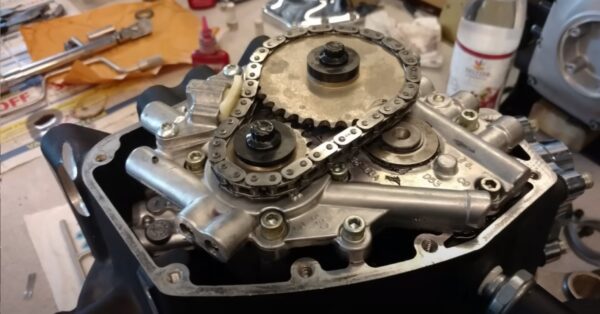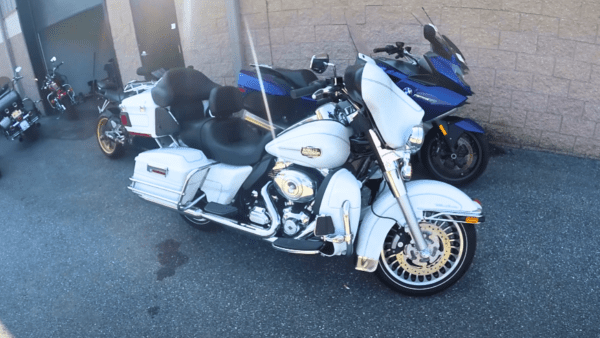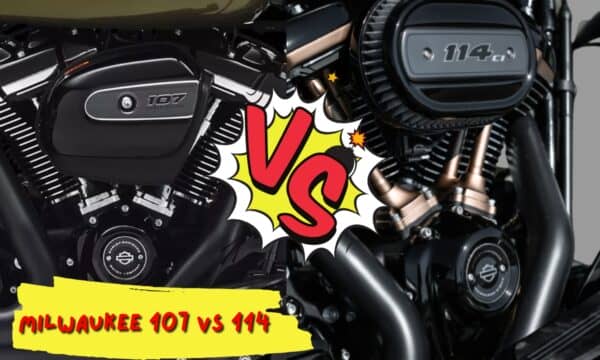
Last year my brother wanted to buy a Harley Davidson 103 and was searching for this bike. I know that Harley is the most popular touring bike brand, but I also know that these bikes have also had drawbacks in the past few years.
Therefore I have done massive research on Harley Davidson to make a good decision like whether it would be worth buying. Harley Davidson 103 had some common engine problems.
If you will also buy this bike, look at the engine problems of the Harley Davidson 103 before buying it.
Let’s dive into:
An overview of the Harley 103 engine
Harley-Davidson, an iconic name in the motorcycle industry, is known for producing engines that offer a unique blend of power and sound.
Among its engine lineup, the Harley 103, officially known as the Twin Cam 103, stands out for its performance and reliability.
The Harley 103 engine was introduced in the 2012 model; the 103 engine was designed to replace the smaller Twin Cam 96 engine.
It boasts a displacement of 103 cubic inches, or 1690cc; this engine was initially available in touring and specific Softail models, enhancing the riding experience for Harley enthusiasts.
The 103 employs Electronic Sequential Port Fuel Injection, ensuring optimal fuel-air mixture and more efficient combustion.
It also features the traditional air-cooled system inherent to most Harley engines; some models also incorporate a precision liquid-cooled system for better thermal management.
It also offers a distinctive rumble cherished by Harley aficionados worldwide.
Features of Harley Davidson 103 engine
Harley Davidson, an iconic name in the motorcycle world, has always been synonymous with innovation, style, and power.
One of their remarkable offerings, the Harley Davidson 103 engine, has gathered attention for its numerous features that make it stand out.
Advanced Braking System
The Harley Davidson 103 engine comes equipped with an advanced braking system.
This feature ensures you have better control over the motorcycle, especially during abrupt stops or emergencies.
Its design enhances safety, offering you peace of mind on long rides.
Use of Basket Gasket
One of the integral components of the 103 engine is the basket gasket. Its primary purpose is to prevent potential oil leaks and maintain a consistent oil pressure within the engine.
By using this type of gasket, Harley ensures the engine’s optimal performance.
Improved Push Butter Seals
With the enhanced push butter seals, the 103 engine is designed to minimize the chances of oil leaks.
This addition makes the engine more efficient, reducing the maintenance cost in the long run.
Advanced Injection and Regulator System
Fuel efficiency and performance are at the core of the Harley Davidson 103 engine due to its advanced injection and regulator system.
This system ensures that the right amount of fuel is delivered to the combustion chamber, optimizing performance, increasing fuel efficiency, and reducing emissions.
Reinforced and Diaphragm Clutch
The reinforced diaphragm clutch in the 103 engine ensures smoother transitions and gear changes.
This clutch system offers better engagement and disengagement of gears, which enhances the overall riding experience.
Electronic Alarm System
Safety is paramount for Harley Davidson. The 103 engine has an electronic alarm system that alerts you of potential threats or issues.
The electronic feature provides an extra layer of security, providing confidence on the road.
Easy Part Availability
Harley Davidson has always been keen on ensuring that their riders get easy access to essential parts.
The 103 engine makes parts readily available, making it convenient to maintain and upgrade your bikes without any hassles.
Harley Davidson 103 Engine Problems
The Harley Davidson 103 engine, part of the company’s Twin Cam series, has been a popular powertrain for several Harley models. However, like many engines, it hasn’t been without its issues.
Cause the too much heat
Several factors can contribute to the excessive heat produced by the Harley Davidson 103 engine:
Air-Cooled Design
Unlike water-cooled engines that use a mixture of water and antifreeze to dissipate heat, the Harley Davidson 103 uses an air-cooled design.
While this adds to the engine’s simplicity and iconic look, it can struggle in extreme conditions or stop-and-go traffic where air circulation is minimal.
High Compression Ratio
The 103 engine boasts a higher compression ratio than many of its peers. This means it can produce more power but also result in higher internal temperatures.
Tight Packaging
The aesthetic appeal of a Harley Davidson often comes from its compact design.
But this compactness can limit the amount of space around the engine, reducing the airflow and, consequently, the cooling efficiency.
Tuned for Performance
Harley Davidson bikes are often tuned for optimal performance, especially in the 103 engine.
However, this tuning can sometimes come at the cost of increased heat generation.
Loose crankshaft issue
The crankshaft is an integral part of any engine. It’s responsible for converting the linear motion of the pistons into rotational motion, which eventually drives the wheels.
Some Harley Davidson 103 engine owners have reported a problem related to a loose or misaligned crankshaft.
It is an operational concern and can lead to significant wear and tear if left unchecked.
Causes
The loose crankshaft issue is often a result of excessive vibration, manufacturing discrepancies, or, in some cases, wear from regular use.
A misaligned crankshaft can result from factory production, while in other instances, hard riding or prolonged high-speed runs can lead to the crankshaft getting out of alignment.
Implications
When the crankshaft is loose or misaligned, it can lead to:
Vibrations
The primary sign of a loose crankshaft is the abnormal vibration felt while riding.
Decreased Engine Efficiency
Misalignment can lead to energy losses. The engine has to work harder to deliver the same power.
Premature Wear
Parts that aren’t appropriately aligned rub against each other, leading to faster wear and a decreased lifespan of the engine components.
Noise
A misaligned crankshaft might cause unusual noises from the engine, which could indicate something more severe.
Potential Solutions
Addressing the loose crankshaft issue can save time and money in the long run. Some potential solutions:
Repairing a loose crankshaft may require a complete engine overhaul. Depending on the severity.
It might involve replacing the crankshaft or re-torquing it to the correct specifications.
Engine creates noise
Over the years, riders have raved about the raw power and unmistakable sound of a Harley. However, like any mechanical product, it has its share of problems.
Understanding the Noise Issue with the Harley Davidson 103 Engine
Motorcycle engines are complex systems with numerous moving parts over time, and these parts can wear out or become misaligned, leading to unexpected noises.
With the Harley Davidson 103 engine, there are a few common reasons behind these noises.
Cam Chain Tensioner
One of the primary causes of noise in the Harley Davidson 103 engine is the cam chain tensioner.
When it wears out, it can create a ticking or clattering noise. This noise can be misinterpreted as valve clatter, but a closer inspection often reveals the tensioner as the culprit.
Valve Train Noise
Harley engines, especially older models, can sometimes produce valve train noises. This is generally due to the valve components becoming worn out or slightly out of adjustment.
Proper maintenance and periodic adjustments can reduce this noise.
Lifter Issues
Lifters play a vital role in ensuring the smooth operation of the engine. If a lifter fails or is not lubricated sufficiently, it can make a noticeable tapping noise, especially during cold starts.
Bearing Wear
Over time, the bearings in the engine might wear out. With increased engine speed, this wear can produce a grinding or humming noise that becomes more pronounced.
Primary Drive Noise
The primary drive, the chain, and the gears can be a noise source if they become misaligned or if there’s excessive slack.
Starting issue
The starting issue frequently reported by Harley 103 users usually involves difficulty cranking up the motorcycle.
It often leads to extended engine cranking sessions, which can cause unnecessary wear on the starter and battery.
Weak Battery
One of the primary culprits for this starting problem is a weak or aging battery. A weak battery can only provide the necessary current if the Harley Davidson 103 requires significant power to crank.
Regular battery checks and timely replacements can help mitigate this issue.
Faulty Starter Motor
Sometimes, the motorcycle may not start with a fully charged battery due to a faulty starter motor.
The starter’s job is to turn the engine over until it starts. It may not perform effectively if it’s defective or nearing the end of its lifespan.
Compromised Ignition System
The ignition system’s primary function is to ignite the air-fuel mixture.
Issues with spark plugs or ignition coils can lead to a weak or no spark scenario, causing starting problems.
Fuel Delivery Problems
An efficient fuel delivery system is essential for smooth starting. Clogged fuel lines, a malfunctioning fuel pump, or issues with the fuel injection system can all hamper the engine’s ability to start promptly.
Hot engine issue
The hot engine issue remains a topic of contention among many riders. The engine overheating characterizes this problem.
Especially when the bike is stuck in traffic or ridden at low speeds for extended periods, such a situation not only affects the performance and longevity of the engine but can also be quite uncomfortable for the rider due to the excess heat radiating from the engine.
Several factors contribute to the hot engine issue:
Air-Cooling Mechanism
Unlike some modern engines that use liquid cooling, the 103 is primarily air-cooled.
This means it relies on ambient air to cool down. In traffic situations or during slow rides, there’s insufficient airflow, causing the engine to heat up quickly.
Lean Fuel Mixture
Harley Davidson engines often run on a lean fuel mixture to comply with stringent emission norms.
A lean, more fuel-efficient mix produces more heat and contributes to the overheating issue.
Compact Design
The bike’s design with the closely packed twin cylinders hinders proper airflow and causes the hot engine problem.
Motorcycle enthusiasts and experts have often shared remedies and solutions to counter this problem, like using engine cooling fans, tuning the fuel mixture, and regular servicing.
Absence of electronic compression
Electronic compression release systems are designed to make engine starting more accessible, especially for larger machines.
They work by opening the exhaust valve slightly when the engine is being started.
It reduces the engine’s compression, making it easier for the starter to turn the engine over. Once the engine starts and runs, the ECR is deactivated, and the engine runs with full compression.
The Harley Davidson 103 engine is not equipped with this electronic compression release.
The absence of electrons can lead to several potential issues:
Hard Starting
With ECR, especially in colder climates or when the bike has been sitting for an extended period, you may find it easier to start your cycle.
The starter motor and battery experience a higher load making the starting process more strenuous.
Increased Wear and Tear
The additional strain placed on the starter motor and the battery can lead to premature wear and tear. Over time, it can result in a shorter lifespan for these components.
Potential Backfire
When a motorcycle engine is hard to start due to high compression, there’s a possibility of fuel accumulating in the exhaust system. If the accrued fuel ignites, it can result in a backfire.
It’s essential to note that many riders have expressed concerns over this missing feature.
Others believe that the 103 engine’s performance remains top-notch with proper maintenance and regular checkups.
Solutions and tips for maintenance of Harley Davidson 103 engine
These are essential solutions and tips for maintaining our Harley Davidson 103 engine.
Oil Change
Regularly changing the oil ensures your engine is lubricated, minimizing wear and tear.
Depending on usage, you must opt for high-quality synthetic oil and replace it every 5,000 miles or sooner.
Air Filter Maintenance
A clean air filter ensures your engine gets the fresh air it needs. Clean or replace the air filter every 5,000-10,000 miles depending on your riding environment.
Spark Plugs
The spark plugs ignite the fuel/air mixture in the engine. Over time, they can wear out or get fouled.
Check and replace them every 10,000 miles or if you notice any degradation in performance.
Valve Adjustments
Over time, the valves of your Harley Davidson 103 engine can get out of alignment. It can reduce engine efficiency and power.
Regular checking and adjusting the valve clearances can prolong the engine’s life and maintain its power.
Inspecting Belts and Chains
Ensure the drive belts and chains are free from cracks, wear and tear. Replace them if they have signs of aging or damage.
Fuel System Care
A fuel additive can help clean the fuel system and ensure it’s free from deposits that might hamper performance.
Smart Riding Habits
How you ride also impacts the longevity and performance of your Harley Davidson 103 engine.
Avoid rapid acceleration and deceleration, especially while the engine is cold. It can reduce strain on the engine parts and ensure they last longer.
What is the cost of maintenance of the Harley 103 engine?
The maintenance cost for the Harley 103 engine can vary based on several factors:
Location
The cost can significantly differ based on whether you’re in a major city or a more rural area. Labor rates in big cities tend to be higher.
Frequency of Use
The more frequently you ride your Harley, the more it will need maintenance.
Regular riding might require frequent oil changes, tire replacements, and other standard checks.
Type of Maintenance
Routine maintenance includes oil changes, air filter replacements, and spark plug replacements, which are less costly than more extensive repairs or replacements.
Dealer vs. Independent Mechanic
Getting your Harley serviced at an authorized dealer might be pricier than an independent mechanic, but it ensures genuine parts and expert brand knowledge.
Parts and Materials
The cost of parts and the materials’ quality can also affect the maintenance cost. Genuine parts might have a premium price tag, but they guarantee better performance and longevity.
From surveys and market analysis, average routine maintenance for a Harley 103 engine, including oil changes, filter replacements, and general checks, can range from $200 to $500 annually.
However, it does not account for any significant repairs or replacements. It’s crucial to budget for unexpected issues that might arise, especially if your bike is no longer under warranty.
FAQ
What is the high mileage for a Harley 103?
High mileage for a Harley 103 engine is typically around 50,000 to 60,000 miles.
But with regular maintenance and care, many owners have reported exceeding this range without significant mechanical issues.
The longevity of the engine largely depends on riding conditions and maintenance practices.
Is a 103 or 107 Harley better?
The Harley 107 offers more power and torque than the 103 due to its more significant displacement. While both engines are reliable, the 107 provides enhanced performance and a smoother ride.
The two choices often come from personal preference and desired power output.
How many ccs is a 103 Harley engine?
The 103 Harley engine is approximately 1,688cc (cubic centimeters). It’s one of Harley Davidson’s Twin Cam engines known for its increased power and performance compared to some earlier models.
What is Stage 4 on a 103 Harley?
Stage 4 on a 103 Harley refers to a performance upgrade kit. It maximizes the horsepower and torque available from the motor.
They often involve larger throttle bodies, high-flow injectors, high-performance cams, cylinder head porting, or larger pistons.
It aims to deliver significant performance gains over the stock configuration at higher RPMs.
Wrapping Up
The Harley Davidson 103 engine is popular among riders due to its power and torque.
But some riders have reported issues such as heat management, premature wear of components, and oil consumption.
It’s essential to note that many problems can be eliminated with proper maintenance, timely upgrades, and addressing any issues early on.
It’s also crucial to remember that every engine has its quirks. But many Harley enthusiasts swear by the reliability and performance of the 103 engine.
You can also check out the Harley 96 engine, 107 engine, 110 engine, 114 engine, 117 engine, 120R engine, 131 engine and Evolution engine Problems.

Ahtsham Younas is a passionate blogger and content writer. He loves to ride motorcycles and learn the mechanical process behind the motorcycles.
He has been writing articles in the motorcycle industry since 2019 and has learned many things about motorbike niches.


